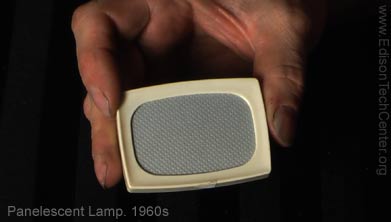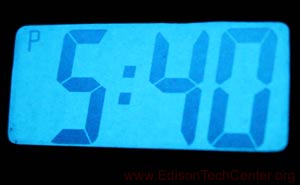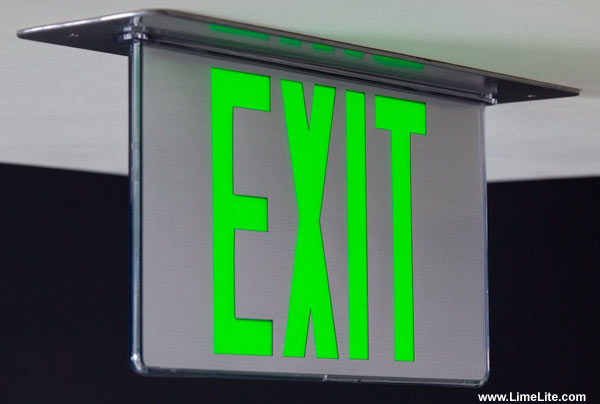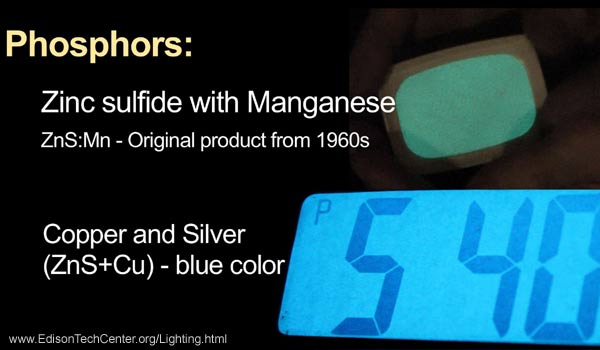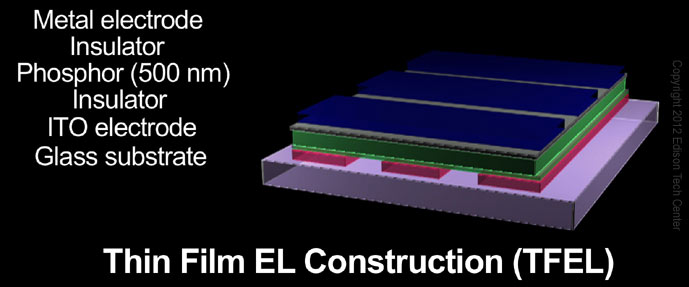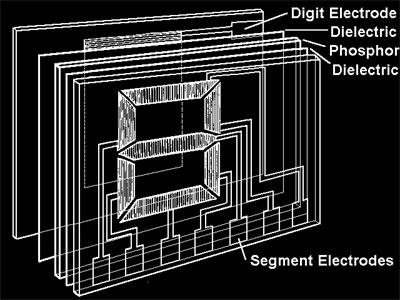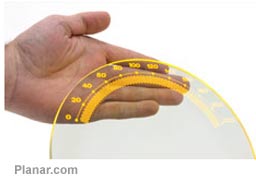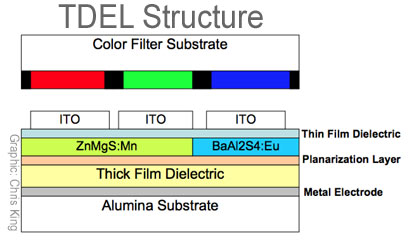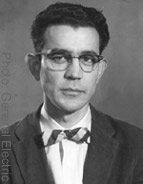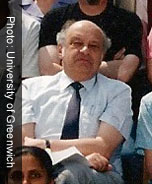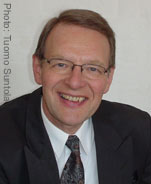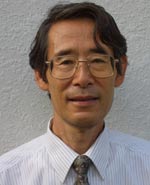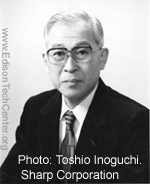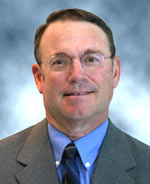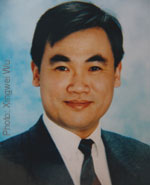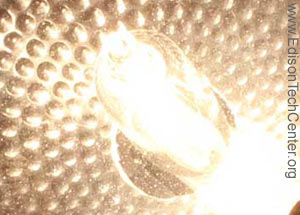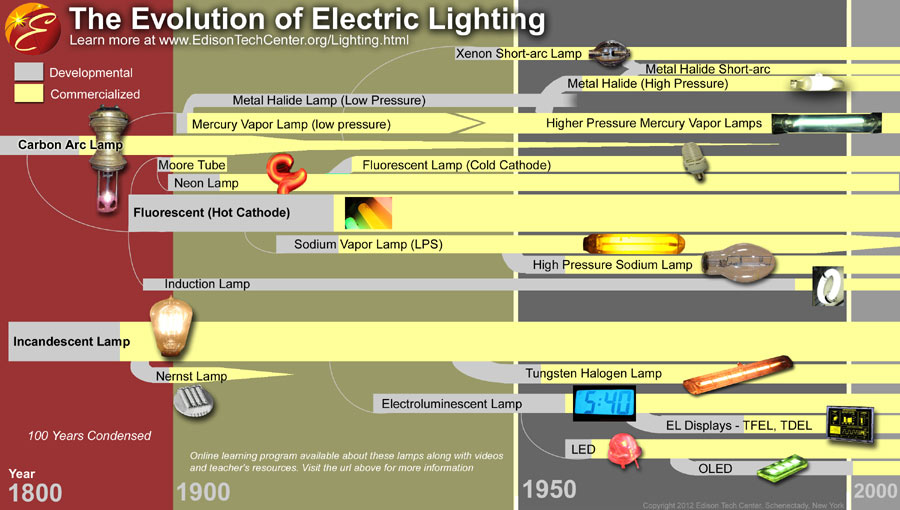Electroluminescent Lamps

Photos:
Edison Tech Center / Planar: www.Planar.com
Using electric current through a phosphor or semiconductor
Commercial History (1950s - Today)
Introduction & Statistics
Inventors and Developments
To put it simply EL lamps or "high field electroluminescent" lamps use electric current directly through a phosphor to make light. Unlike most lamps, they can be shaped to be extremely flat, or in narrow wire-like shapes.
Electroluminescence or "EL" is the non-thermal conversion of electrical energy into light energy. This phenomenon is used in EL lamps, LEDs, and OLEDs. In this page we talk about EL devices which create light by exciting high energy electrons in phosphor materials like ZnS:Mn. This type of device uses "high field electroluminescence".
-It is different from LEDs/OLEDs in that OLEDs use a p/n junction (two semiconductive materials where electrons and holes combine on the boundary). In EL there is a layer called activator in which the whole layer is emitting light, not just the boundary
-It is different from incandescence. With incandescence you send current through a material, this creates heat and that heat emits light at a high enough temperature.
More on How it EL Works (below)
Common uses: nightlights, decorative luminescent clothing, watch illumination, flat wall decorative illumination, durable waterproof displays, medical tool display screens, and most recently computer monitors and billboards
Classic TV sets use electroluminescence. CRTs (Cathode Ray Tubes) have an electroluminescent coating made of rare earth oxides and oxysulfides. These materials glow when struck by electrons fired from a cathode in the back of the tube.
All credits and sources are located at the bottom of each lighting page
The consumer may be familiar with brand names Panelescent and Indiglo which feature lamps and watch lights that use EL. Planar and Sharp Corporation have pioneered the use of electroluminescence in displays.
Left: One of the first EL lamps on the market: Panelescent by Sylvania. 120 V .02W nightlight, directly plugs into wall and provides a soft green glow.
Advantages:
-Low wattage
-Long life
-No external circuitry required (no ballast needed to limit current, it can be plugged directly into AC power and will self-regulate power through it's own resistivity)
-Can be manufactured into flat flexible panels, narrow strings, and other small shapes
-Can be made into waterproof computer monitors which are more durable and light weight than LCDs or Plasma screens.
-Not directional like LCDs when used as a computer monitor, looks good at all angles
-EL displays can handle an impressive -60 C to 95 C temperature range, which LCD monitors cannot doDisadvantages:
-Not practical for general lighting of large areas due to low lumen output of phosphors (so far)
-Poor lumens per watt rating, however typically the lamp is not used for high lumen output anyway
-Reduced lumen output over time, although newer technologies are better than older phosphors on this point
-Flexible flat EL sheets wear out as they get flexed, durability is being worked on
-The lamps can use significant amount of electricity: 60-600 volts
-Typical EL Needs a converter when used with DC sources such as on watches (to create higher frequency AC power, this is audible)
EL Statistics
*Lumens per watt: 2-6
*Lamp life: 2,000 - 50,000 hours
*CRI - N/A
*Color Temperature - N/A
*Available in 0.01 - 3 WLeft: EL background with LCD display,
marketed as "Indiglo" by Timex in the 1990s
A electroluminescent exit sign, easy to operate on low power and very long lamp life. Photo: LimeliteThere are several variations on how EL works depending on whether you are talking about a flat panel light, rope light, DC EL technology, thin film EL display, or other complex design.
EL devices are monocarrier devices which give off light due to impact excitation of an optical center like the Mn atom. They do this by transporting high energy electrons in the host matrix (commonly ZnS).
For simplicity we will describe a simple EL lamp:
High voltage AC power passes through a thin layer of phosphor or semiconductor and this causes emission of light. Two layers of solid material (one being transparent) act as electrodes and a powder phosphor or semiconductor in between glows when electrons pass through it from one electrode to another. Light escapes the device on one side thanks to the development of transparent conductors like indium tin.
Thick phosphor powder EL Lamps are used in most simple lamps used for illumination including the night lights and exit/safety signs. The graphic below shows thick phosphor lamps.
Thin Film and Thick Dielectric EL (TFEL, TDEL): this technology is used in a variety of applications, EL displays (ELDs) are the most common use. A display is not a "lamp" in the traditional sense, however we cover it here due to its importance in the development of EL. TFEL and TDEL often use rare earth materials such as Er, Tm, In, and more.
TFEL - Thin Film Electroluminescent Devices
TFEL emerged in the 1950s and it different in that it contains thinner active layers and a different construction. TFEL was an improvement over thick powder construction, it allows for small devices and precise control of pixels on a display. It was a challenge to develop ways to deposit/grow thin polycrystalline films onto a substrate (the supporting material) however many processes have been developed to allow TFEL technologies to expand. Below we highlight the basic construction of a TFEL device.
Note:
-TFEL has a maximum of 6 lumens per Watt as of 2012.
-TFEL typically requires 1.5 Megavolts per centimeter to cause the active layer to make lightVideo of TFEL construction:
How TFEL works:
TFEL has a phosphor layer that emits light when a big enough electrical field is applied. This thin film of a phosphor requires such a high level of energy that there is a potential for a damaging short circuit through imperfections in the phosphor. Insulating layers are used between the electrode and the phosphor on both sides to limit current and make the TFEL work properly.TFEL devices behave like 3 capacitors in series: voltage rises and a breakdown voltage is reached where current flows through the semiconductive layer (the phosphor) which excites the phosphor and makes light. The insulator layers act as capacitors, with voltage building and breaking through.
Before you see how the EL device works you may want to review how a capacitor works in this video:
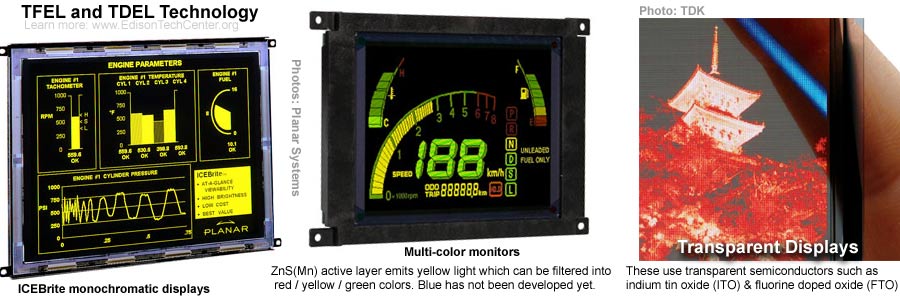
Efficiency:
As voltage increases more and more Manganese centers become excited and the device brightens. (6 lumens per Watt) After a while the increasing voltage does not make the device brighter because the Mn centers become saturated, efficiency goes down at this point (to 3 lumens per Watt for example)Colors:
Making primary colors used in displays has been a major problem preventing the use EL for TV or Computer monitors until recently. Engineers have used filters to make light. Colors can be made by filtering white into red, green and blue, but developing an efficient white phosphor has been hard. Engineers have also worked on developing separate RGB phosphors.
ZnS:Mn makes a green, which is the most efficient phosphor. Many EL displays are green and red because they can filter red from the green. CaS:Eu creates red but it has not been bright enough. Making an efficient blue phosphor with a good enough brightness has been the challenge. 0.1 lumens per Watt, achieved by Heinrich Hertz Institute is just not good enough. Remember that this must compete with LCD technology in order to survive on the market. BaAl2S4:Eu is a primary phosphor used for blue. While TFEL has had trouble getting acceptable efficiency, TDEL has achieved a more acceptable rate of 3 lumens p/W.
Digital displays using EL to backlight liquid crystal number segmentsEL Phosphors:
Most ELs are made with ZnS:Mn (zinc sulfide doped with manganese)
Other materials used to make EL lamps are
- Zinc sulfide with Cu or Silver
- Zinc sulfide with various alkali metals for blue, green, red, white
-diamond with boron - blue color
-III-V semiconductors InP
-GaAs, and GaN
-Inorganic SemiconductorsEpitaxy
Thin film EL uses a process of epitaxy to grow crystals on top of a substrate. This process allows one to create a "film" or ultra-thin layer of material (measured in nanometers (nm)) on glass or other flat surface (this surface provides structure and is called the 'substrate'). TFEL epitaxy creates layers about 500 nanometers thick, although the size varies depending on the product. Later on TDEL (thick dielectric EL) was developed to produce a product with higher luminosity than TFEL. TDEL uses a structure where electrodes are separated from the thicker phosphor by a thin insulative layer. Both TFEL and TDEL use epitaxy, there are many forms of epitaxy from MBE (molecular beam) to ALE (Atomic Layer Epitaxy) (which was renamed ALD (Atomic Layer Deposition)). Understanding epitaxy requires a bit of time, we recommend online lectures and web sites for this area. Read more about ALD from Tuomo Suntola here (PDF).
Transparent and Non-transparent EL displays
One way to build a non-transparent TFEL display is to use two layers for plastic film or glass, one is coated with indium tin oxide (ITO) or other semiconductor while the other flat surface has a reflective material. Light will be produced in the 'active' layer of phosphors (ZnS Mn for example). Light emitted in the wrong direction will be reflected off the back plate and go through the opposite side which has the transparent semiconductor, this way you achieve a higher luminosity. With many individually controlled units and a controlling computer you can turn the unit on or off, collectively this will make a display screen. In a multi-color display filters applied over top of the units can control whether the unit emits red, yellow or green light. Blue has not been developed yet, and it is because of this EL displays cannot currently compete with LCD technology for full-color consumer displays.
Transparent EL displays two layers of transparent conducting films (TCFs) as the electrodes with the phosphor in between. Since they do not have a reflective backing they do not currently produce the same level of brightness as standard EL displays. Despite this the display has some very interesting and unique applications which have not become widespread yet.
Transparent conducting films (TCFs) include indium-tin oxide (ITO) and fluorine doped tin or zinc oxide (FTO)(FZO). ITO is also used in the thin-film solar industry. Carbon nanotube technology is an organic conducting film which could replace expensive rare earth materials like indium. Poly(3,4-ethylenedioxythiophene) PEDOT films and other polymer films also have potential to replace ITO. Making newer cheaper materials is important for seeing the growth of EL displays and lights in the daily life of consumers.
This type of lamp makes light as electrons radioactively combined in holes of a semiconductor. Understanding how semiconductors work on a molecular level requires a long description or entire lecture. The Indian Institute of Technology Madras has a multi-video lecture starting with a 59 minute video on solid state materials.
TDEL:
TDEL or thick film dielectric EL technology is known for providing a solution to the blue problem. It provides the only full color RGB display technology available at this time.Thick film dielectric displays have proven to be effective: they have a good brightness (luminosity) and have a decent efficiency. iFire Group and TDK Corporation currently hold the patents for this technology. The phosphor in TDEL is 10K - 20K nanometers thick. Some TDEL like that used in displays uses two layers of phosphors. The bottom thick layer is resistant to dielectric breakdown, so it can transport a higher current and make a brighter light. Above the thick dielectric layer is colored phosphors of ZnMgS:Mn (green) and BaAl2S4:Eu (blue). With this system RGB can be created.
2. Inventors and Developments:
Electroluminescence was used as early as 1936 by scientist Georges Destriau. It wasn't until the 1950s when companies began developing the technology to be used for practical applications.
1936 - Georges Destriau, who was an associate of Marie Curie in her lab in Paris began studying electroluminescence. He coined the term as he worked with ZnS powders.
Paris, France1958 - Elmer Fridrich while working for General Electric developed EL lamps, some of which where quite sophisticated in design. Fridrich also became famous for inventing the halogen lamp and advancing fluorescent lamp technology. He was a key member of engineering teams at Nela Park, Ohio and Schenectady, New York.
Photo: General Electric1958 - Nataliya Andreeva Vlasenko and A. Popkov: Developed the first TFEL prototype and worked on methods for boosting luminosity. They pioneered early work on DC EL lamps as well.
Kiev, Ukraine1968 - Aron Vecht develops DC EL technology for lamps and watches. London, UK
Photo: University of Greenwich1974 - Tuomo Suntola develops ALE Epitaxy for Thin film electroluminescent (TFEL) technologies. This method of depositing thin semiconducting films on a substrate has become a basis for TFEL production. Thin polycrystalline films are about 500 nanometers thick. Thin films allow for a more uses of EL than clumsy thick phosphor powders.
Lohja, Finland
Photo: Tuomo Suntola1970s - Hiroshi Kobayashi worked over 30 years on inorganic electroluminescent devices with late Professor Shosaku Tanaka. His work helped with the commercialization of inorganic EL displays in Japanese industry. A great deal of work was done at Tottori University. He retired in 2003 and now lives in Tokyo.
Tottori Prefecture / Tokyo, Japan
Photo: Hiroshi Kobayashi1974 - Toshio Inoguchi develops the first practical ELD (electroluminescent display) at Sharp Corporation. He uses TFEL to make this possible. His displays have long life and are brighter in luminosity. His work set the stage for later advancements and kept Sharp at the leading edge for the next few decades. The displays were used first as displays for medical instruments. The displays were monochromatic, but a better option than CRTs.
Osaka, Japan
Photo: Toshio Inoguchi and Sharp Corporation1980s - Christopher N. King and team* develop advanced EL displays which use thin film technology. The team had started at Tektronix and launched spin-off Planar Systems in 1983. The new displays increase the number of available colors as time goes on. Increasing luminosity and contrast to compete with LCDs became important in the 1990s and 2000s. Since the 90s the engineers at Planar have improved the EL display, they have achieved better luminosity, contrast and efficiency. *Jim Hurd, John Laney, Eric R. Dickey (ICEBrite)
Beaverton, Oregon
Photo: Chris King1990s - Xingwei Wu develops TDEL technology. Thick Dielectric EL displays achieve blues bright enough to be used in full color displays. TDEL is brighter than TFEL, and uses "color by blue" method to achieve good RGB. TDEL is the first full color capable EL technology. Dr. Xingwei Wu is the primary engineer at iFire Technology.
Oakville, Ontario, Canada
Photo: Xingwei Wu. iFire Technology Ltd.
2016 - You - Choose a career in engineering and be the next pioneer! LEARN MORE
2000s - EL lamps become more affordable to the average consumer and are used in decorative clothing and thin film application on various products. As a lamp for general illumination EL technology is not preferred due to limited maximum lumen production combined with low efficiency compared with LEDs. The unique spatial aspect of the EL lamp (flat and flexible) allows it to maintain a market niche.
EL displays have come a long way since 1980 however a better blue phosphor which can be used in displays is still needed. Developing a high-luminosity, high-efficiency blue would allow a red-green-blue combination that would allow the EL display to better compete with LCD.
Further reading in more detail:
A History of Electroluminescent Displays by Jeffrey A. Hart, Stefanie Ann Lenway, Thomas Murtha. 1999Lamps are presented in the order of chronological development
|
Previous: Halogen Tungsten Lamp 1955 |
Next: LED Lamp 1962 |
 |
|
Arc
- Incandescent - Nernst
- Neon - Mercury
Vapor - Sodium Lamp - Fluorescent
- Halogen - EL
- LED - MH
- Induction
|
COMMENTS?
Help us edit and add to this page by becoming a ETC volunteer!
Give us feedback on this and other pages using our Facebook PageWebsite, graphics and article by M. Whelan
Thanks to assistance from Chris King, Toumo Suntola and Toshiyuki Matsumura
Sources:
Greenwich University
A History of Electroluminescent Displays by Jeffrey A. Hart, Stefanie Ann Lenway, Thomas Murtha. 1999
Sharp Corporation
The General Electric Story. Hall of History. Schenectady Museum
Toumo Suntola
"Electroluminescent Displays" by Christopher N. KingPhotos:
Edison Tech Center
Planar Systems www.Planar.com
LimeLite www.Limelite.com
Toumo Suntola
Christopher N. King
iFire Technology Ltd.
Prof. Emeritus Hiroshi Kobayashi of Tottori University
Photo Use:
Edison Tech Center Photos may be used/reproduced for educational purposes, the photos may NOT be altered except for resizing. The Edison Tech Center must be credited. Linking to this page is preferred for online publications.
Back to Home
Copyright 2013 Edison Tech Center

